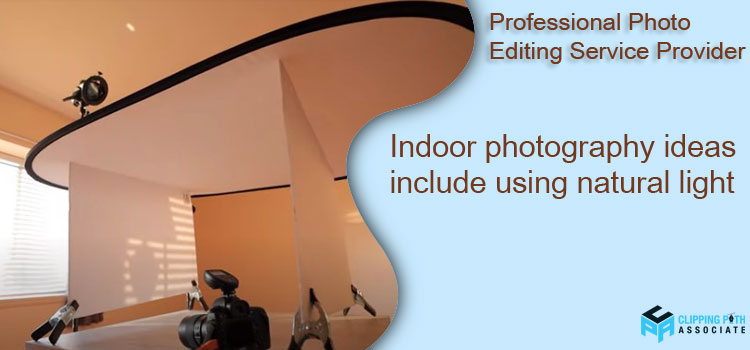Theodore Lowe, Ap #867-859
Sit Rd, Azusa New York
Find us here
Indoor Photography Ideas using Natural Light

Whether you're a professional photographer or an amateur looking to improve your skills, there are plenty of creative ideas to explore within the comfort of an indoor setting. One of the key aspects of indoor photography is the use of natural light, which can be diffused or manipulated to create various moods and effects.
Additionally, experimenting with different compositions, props, and backdrops can add depth and interest to your images. We will delve into some exciting indoor photography ideas that will help you unleash your creativity and capture captivating shots.
1.Benefits of Indoor Photography
Indoor photography offers a world of creative possibilities that can be explored right within the walls of your own home. Whether you are a seasoned photographer or a beginner, there are numerous benefits to capturing stunning indoor shots. From capturing intimate moments in the comfort of your home to exploring unique perspectives and perfecting lighting techniques, here are some compelling reasons why you should delve into the world of indoor photography.
Indoor photography allows you to turn your home into a personal photography studio. It provides a comfortable and familiar environment where you can capture special moments of your loved ones without the need for elaborate setups or travelling to different locations. Whether it's a cozy breakfast shot in the kitchen or a candid moment in the living room, you can create beautiful memories within the walls that hold precious stories. Furthermore, photographing in the comfort of your home enables your subjects to relax and be themselves, resulting in more natural and authentic images.
Indoor photography offers endless opportunities to experiment with different angles, compositions, and perspectives. By taking advantage of the various elements in your home, such as furniture, patterns, or architectural features, you can create visually interesting and captivating images. Get creative and think outside the box – you might discover unique perspectives that you never thought existed. Whether it's shooting from above, below, or through different objects, indoor photography lets you showcase your creativity and capture everyday objects in extraordinary ways.
Lighting plays a crucial role in photography, and indoor settings provide an ideal environment to master various lighting techniques. Unlike outdoor photography, indoor lighting can be controlled and manipulated to achieve the desired effect. Experiment with natural light flooding through a window, or employ artificial lighting techniques like using softboxes, umbrellas, or reflectors to create different moods and enhance the atmosphere of your images. By understanding how lighting affects your subjects and experimenting with different setups, you can develop a strong foundation in lighting techniques that will benefit your overall photography skills.
Indoor photography offers a multitude of benefits, providing you with the freedom to capture moments in the comfort of your own home and allowing you to unleash your creativity. By exploring unique perspectives and perfecting lighting techniques, your indoor shots can become captivating works of art. So, grab your camera, venture indoors, and unlock the potential that awaits you within the walls of your home.
2.Creative Indoor Photography Ideas
Discover the art of indoor photography with these innovative ideas that will help you capture stunning images in the comfort of your own space. From playing with lighting to creating unique backgrounds, these ideas will take your indoor photography skills to the next level.
Next time you find yourself stuck indoors with a camera in hand, don't fret! There are plenty of creative indoor photography ideas that can help you capture stunning images without stepping foot outside. In this article, we will explore three intriguing techniques you can try to add a unique touch to your indoor photography. So, let's dive in and discover how you can utilize natural light, experiment with shadows and silhouettes, and incorporate everyday objects to create visually captivating indoor photographs.
2.1. Utilizing Natural Lig

One of the most important aspects of indoor photography is lighting, and what could be more enchanting than natural light streaming through a window? Harnessing the power of natural light not only adds a soft and subtle touch to your images but also creates a warm and inviting atmosphere. To make the most of this technique, place your subject near a window and experiment with different angles and positions. You can achieve various effects by shooting directly into the light, positioning your subject in front of the window, or using curtains to diffuse the light for a dreamy and ethereal feel. Remember to adjust your camera settings accordingly to achieve the desired exposure.
2.2. Experimenting With Shadows And Silhouettes

Shadows and silhouettes can add drama and mystery to your indoor photographs, making them visually striking and captivating. To create compelling shadow play, position your subject between a light source and a blank wall or surface. By adjusting your camera settings and experimenting with different angles, you can capture intriguing shapes and forms. Silhouettes, on the other hand, can be achieved by positioning your subject in front of a well-lit background and exposing for the background rather than the subject. This technique not only emphasizes the outline of the subject but also allows for imaginative storytelling through the absence of detail. Whether it's a simple everyday object or a person, shadows and silhouettes can evoke emotion and add an artistic flair to your indoor photographs.
2.3. Incorporating Everyday Objects

Who says you need fancy props or extravagant setups to create captivating indoor photographs? The beauty of everyday objects lies in their familiarity and ability to tell a story. From a cup of steaming coffee to a stack of books or a vase of flowers, incorporating everyday objects can add depth and interest to your indoor photography. Experiment with composition and placement, considering lines, shapes, and textures to create visually pleasing images. You can also play with perspective by shooting from different angles or getting up close to capture intricate details. By turning the ordinary into the extraordinary, you can transform mundane moments into extraordinary photographs. Remember, indoor photography offers endless possibilities for creativity. By utilizing natural light, experimenting with shadows and silhouettes, and incorporating everyday objects, you can elevate your indoor photography game and create stunning images that captivate viewers. So, grab your camera, unleash your imagination, and let your creativity shine through your indoor photographs. Happy shooting!
3.Tips For Success In Indoor Photography
Indoor photography offers a variety of opportunities to capture stunning images in the comfort of your own home. Whether you're a seasoned professional or an enthusiastic beginner, these tips will help you achieve success in your indoor photography endeavors.
3.1. Setting Up A Home Photography Studio
Creating a designated space for indoor photography can greatly enhance your results. Consider the following tips when setting up your home photography studio:
- Choose a well-lit area: Natural light is ideal, so position your studio near a large window. This will provide soft, diffused lighting for a more flattering effect on your subjects.
- Control the background: Use a neutral-colored backdrop or invest in a fabric backdrop that complements your subjects. This will ensure that the focus remains on your subject and eliminate any distractions.
- Arrange your props and equipment: Organize your props, tripods, and lighting equipment in a way that allows easy access and creates a clutter-free environment.
- Consider space utilization: Make the most of your available space by utilizing shelves or storage units to keep your gear organized and within reach.
3.2. Choosing The Right Equipment
Having the right equipment is crucial to achieving professional-looking indoor photographs. Here are some essential considerations when selecting your gear:
- Camera: Invest in a DSLR or mirrorless camera that offers manual control over settings such as aperture, shutter speed, and ISO. This will allow you to have full creative control over your shots.
- Lenses: Choose lenses with a wide aperture (low f-number) to capture sharp subjects and blur the background effectively. A prime lens or a versatile zoom lens can be ideal for indoor photography.
- Tripod: A sturdy tripod is essential for indoor photography to ensure sharp images, especially in low-light conditions. Look for a tripod with adjustable height and stability.
- Lighting equipment: Consider investing in continuous or flash lighting to overcome insufficient natural light. Softboxes or diffusers can help create softer and more flattering light on your subjects.
3.3. Post-processing And Editing
Post-processing and editing play a vital role in elevating your indoor photographs from good to outstanding. Consider the following tips for effective post-processing:
- Adjust white balance: Correct any color casts caused by different lighting conditions to ensure accurate color reproduction.
- Enhance exposure and contrast: Fine-tune the brightness and contrast levels to bring out the details in your images.
- Sharpen and reduce noise: Apply selective sharpening techniques to enhance the details, and reduce noise for a cleaner and more professional look.
- Experiment with filters and effects: Play around with different filters and effects to add a creative touch to your indoor photographs.
By following these tips, you'll be well on your way to capturing stunning indoor photographs. Remember, practice makes perfect, so don't be afraid to experiment and let your creativity shine!
Frequently Asked Questions On Indoor Photography Ideas
How Do You Make Indoor Pictures Look Good?
To make indoor pictures look good, ensure proper lighting by using natural light or adjusting artificial lighting. Avoid using flash and use a tripod to reduce blur. Experiment with angles and composition, and consider the background. Lastly, edit the pictures to enhance colors, contrast, and sharpness.
How Do You Take Good Pictures Of The Inside Of Your House?
To take good pictures of the inside of your house, use natural light, declutter, frame the shot, adjust the camera settings, and use a tripod.
How To Do A Cool Photoshoot At Home?
To do a cool photoshoot at home: 1. Choose a well-lit area in your home. 2. Use natural light or set up some lighting equipment. 3. Find unique backgrounds or create DIY backdrops. 4. Experiment with different poses and angles. 5.
Edit your photos using photo editing software for a finished look.
What Are Some Pitfalls Of Indoor Photography?
Some pitfalls of indoor photography include limited lighting options, potential for harsh artificial lighting, crowded spaces, noise interference, and lack of natural scenery.
Conclusion
These indoor photography ideas provide a wealth of creative opportunities to capture striking images within the comfort of your own home. From utilizing natural lighting to experimenting with different angles and props, there are endless possibilities to showcase your artistic vision.
So grab your camera and start exploring the boundless potential that indoor photography has to offer. Let your imagination run wild and watch as your photographs come to life. Happy shooting!
Related blog posts
10 Best Ways to Share Photography With Your Clients
Capturing the perfect shot is only half the battle; sharing your stunning work with your clients is where the magic truly happens. As a photographer, you know how essential it is to deliver your photos in a way that wows and delights.


